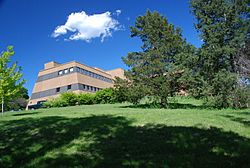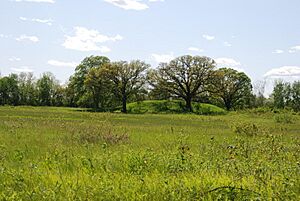Dickson Mounds facts for kids

Museum at the site
|
|
| Location | Lewistown, Illinois, Fulton County, Illinois, |
|---|---|
| Region | Fulton County, Illinois |
| Coordinates | 40°21′2.16″N 90°6′57.24″W / 40.3506000°N 90.1159000°W |
| History | |
| Founded | 800 CE |
| Abandoned | 1250 CE |
| Cultures | Middle Mississippian culture |
| Site notes | |
| Excavation dates | 1937 |
| Architecture | |
| Architectural styles | burial mounds, platform mound |
| Architectural details | Number of monuments: |
|
Dickson Mounds
|
|
| NRHP reference No. | 72000457 |
| Added to NRHP | May 5, 1972 |
| Responsible body: State of Illinois | |
Dickson Mounds is an important Native American historical site. It includes an ancient settlement and a complex of burial mounds. The site is located near Lewistown, Illinois, in Fulton County. It sits on a low hill overlooking the Illinois River.
This large site has at least two cemeteries and many burial mounds. Some mounds were built one on top of another. The Dickson Mounds site was first used around 800 CE and continued until after 1250 CE. It is named after Don Dickson, a chiropractor who started digging there in 1927. He opened a private museum to show the skeletons he found. In 1992, the display of 237 skeletons was closed by Governor Jim Edgar due to concerns from Native American groups.
Don Dickson found the burial mounds on his family farm. Instead of moving the bones, he carefully removed only the dirt around them. He first covered his dig site with a tent. Later, he built a permanent building to house his private museum.
The Dickson Mounds Museum was built on the site in 1972 by the state of Illinois. This museum teaches visitors about the lives and culture of Native Americans. These people lived in the Illinois River valley for 12,000 years, starting after the last ice age. The museum is part of the Illinois State Museum system.
Contents
Life by the Illinois River
Most hunter-gatherer groups move around a lot. But the Illinois River valley was so rich in fish, shellfish, and game animals. This allowed people to create semi-permanent homes here. Studying these sites helps us understand how Native Americans lived and what technology they used.
A large area of wetlands nearby is being restored as part of the Emiquon Project. These wetlands provided much of the food for the people living at Dickson Mounds. In 2009, archaeologists found pottery pieces, arrowheads, and house foundations. These items date back to about 1300 CE.
Many people who lived here were buried at Dickson Mounds. Their skeletons were shown to the public from the 1930s until 1992. At that time, the burial display was respectfully closed. This happened because Native American groups wanted to honor their ancestors in a different way. It is thought that at least 3,000 people are buried at this site.
Earlier burials were in mounds that were still being built in the 800s. Later burials were in cemeteries. This shows a change over time. People moved from focusing on burial mounds to building platform mounds in the center of their towns. Some burials at Dickson Mounds show unique practices. For example, four people were buried with pots replacing their heads. This was not a common practice in earlier times.
After the burial display closed, the museum was updated. It now has galleries that tell the site's history. For example, the River Valley Gallery shows how people lived since the last Ice Age. The "Reflections on Three Worlds" Gallery explains how experts use findings to learn about the residents' lives.
Today, three excavated homes are open for visitors at the site. The museum displays continue to share the story of prehistoric life in the area.
How People Lived and Their Health
The different burial sites at Dickson Mounds show all known periods of Native American culture in Illinois. Experts studied over 800 Native American skeletons from these sites. They found a shift from hunting and gathering to farming. This change also led to big differences in people's health.
Earlier settlements (950–1050 CE) mainly relied on hunting and gathering. This gave people a varied and healthy diet. At this time, the population was small and mostly independent. They traded little and moved between seasonal camps.
From 1050 to 1175, Dickson Mounds began to change. People started mixing hunting and gathering with farming, especially growing corn (maize). They also began to build more permanent homes and trade with other groups. From 1175 to about 1350, the population grew a lot. They developed complex, permanent settlements. These changes happened because they relied more on farming and traded more over long distances.
These big changes, from small groups of hunter-gatherers to large farming communities, affected people's health. After looking at bone growth, teeth, injuries, and death rates, archaeologists found a decline in health. This happened after people started farming more. Skeletons of farmers at Dickson Mounds show more tooth problems, iron-deficiency anemia, bone injuries, and back problems.
The health decline at Dickson Mounds likely happened for several reasons. Relying more on farming meant a less varied and less nutritious diet. Farming also involved harder physical work. More crowded settlements made it easier for diseases to spread. Some experts also think that trading with larger groups like Cahokia might have made people give away too much food for fancy items. This could have also affected their health.
How Society Was Organized
Studying the burials at Dickson Mounds gives us clues about how early Native Americans organized their society. People at Dickson Mounds had different social ranks, like a ladder. The items a person was buried with often showed their social status. For example, many tools, copper decorations, and items made from imported materials suggested a high rank. Burials with pots, spoons, and beads were more common and showed a more modest social rank.
Age and gender also played a role in status, which is not common in all societies with ranks. Burials were grouped by age and gender. For instance, one group of burials contained older men with high status. Another group had younger people with lower status. Specific objects showed the status of different age and gender groups. Objects for practical use, like cutting tools, often showed a man's status. Cultural and religious items, along with ornaments, showed a woman's status. Marine shells often showed the status of children.
Differences in social classes at Dickson Mounds are also clear from studying the health and heights of the skeletons. For example, children from higher-ranking families tended to be taller and healthier. This was probably because they had better diets and did less hard work than children from lower classes.
Trade Connections
By 1200 CE, Dickson Mounds was part of a large trade network. They traded with many different groups from the Plains area, the Caddoan area, and Cahokia. Cahokia, a very large ancient city, provided luxury items to Dickson Mounds. These included copper ornaments and necklaces made from marine shells. In return, Dickson Mounds traded food items like meat and fish.
To trade food for luxury goods, the people at Dickson Mounds had to produce extra food. This led to more intense farming, which had serious effects on their health and society.
Why the Site Declined
The population at Dickson Mounds seems to have disappeared between the late 1200s and mid-1300s. No one knows exactly why. Possible reasons include warfare, changes in climate, and widespread diseases. Climate change might have harmed farming, especially corn, which the people relied on for food and trade. The growing population and increased trade also meant more contact. This could have led to the spread of infectious diseases, which might have caused the decline.
Commemoration
The Dickson Mounds site was added to the U.S. National Register of Historic Places in 1972.
See also




